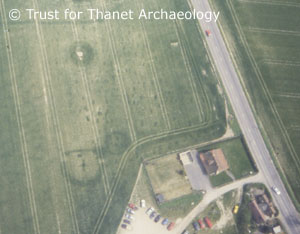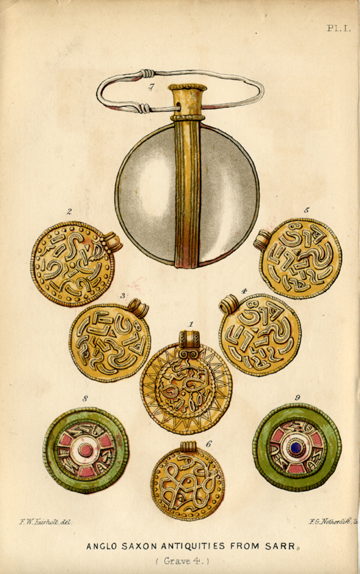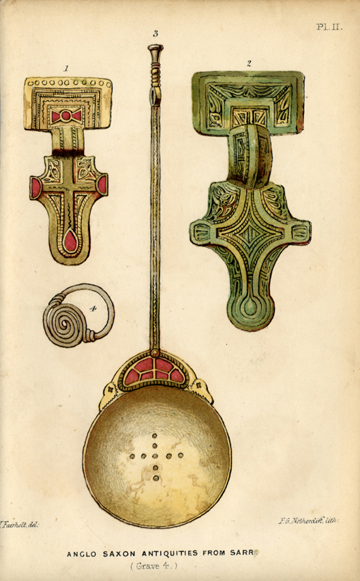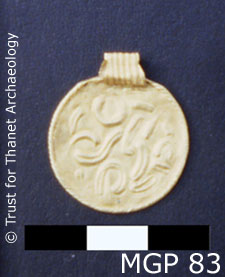
Museum Guide
Gallery Guide
Curators Introduction
Anglo Saxon Thanet Cemeteries
Settlement
The Pagan Period
The Conversion Period
List of Displays


Anglo Saxon Thanet
The collapse of Roman rule in Northern Europe accelerated the migration of Germanic people from areas which are now within Northern Germany and Southern Scandanavia.
These people migrated in different waves each experiencing different levels of interaction with the former Roman World.
It is possible that the earliest generation of Germanic settlers came as Soldiers to assist the increasingly diverse elements of the late Roman army. Later these Soldiers and their families settled all over Europe.
Cemeteries
The Isle of Thanet is rich in funerary evidence for the Anglo Saxon period. Seven Anglo Saxon period cemeteries have been investigated on Thanet between the 18th/19th Centuries and the present day. A further two extensive cemeteries of Anglo Saxon date visible as crop marks have been identified from aerial photographs and a further eleven separate sites of small grave groups or isolated burials which may represent parts of larger cemeteries are recorded on the Island. The cemetery evidence on Thanet dates between the late 5th to early 8th Century.

Settlement
The evidence for Settlement is not as rich. Occupation evidence in the form of Sunken Featured buildings are known from four sites and ditches and pits from three other sites. Other settlement evidence at St Peters consisting of the remains of timber structures showing as cropmarks have been identified from Aerial Photographs.
The Pagan period
According to the 8th Century historian Bede, Kent was settled in the 5th century by the Jutes, who also settled on the Isle of Wight. The areas of the East, South and West Saxon Kingdoms were settled by peoples from Old Saxony and Germanic settlers from Angeln settled Mid Anglia, Mercia and other areas such as Northumberland.
We know that Bede over simplified these events and that other Germanic groups also settled in Britain at different times. There are variations in the type of artefacts found on Saxon sites which suggest that Kent was not only influenced by Jutish peoples but also the Romano British population and the Frankish kingdoms.
In the 6th Century there appears to have been an influx of wealthy Frankish people from Gaul; now Northern France and North West Germany. This is reflected in artefacts found in some female graves in Thanet such as Sarre, Grave 4, where a female was buried accompanied by a metal weaving sword, glass vessels and a crystal ball suspended from the waist.

She was also accompanied by a spoon as well as other artefacts; the sleeves of her garment had been woven using gold thread and she wore brooches on her shoulder

Male burials were often accompanied by weapons – swords, spears, and shield bosses as well as knives.

The Conversion Period
In the late 6th Century Æthlebert the King of Kent married a Christian Frankish Princess. Æthlebert was converted to Christianity by Augustine who arrived from Rome in 597 on a mission to spread Christanity. Augustine’s landing is traditionally located at Ebbsfleet; Thanet.

The conversion of Æthlebert enabled the missionaries from Rome to establish the first archbishopric in England at Canterbury. Æthlebert’s conversion encouraged other Saxon Kings to follow and by the late 7th Century all of the Anglo Saxon Kingdoms had accepted Christianity. The conversion to Christianity allowed more contact with Scholars from the southern areas of the continent and there was more contact through Gaul to England.
A wider range of goods were traded between England and the Continent including some originating from the Byzantine Empire. These Christian and continental influences are reflected in the graves of the people of this period during this time known as the Conversion Period (7th – 8th centuries).
The placing of artefacts and dress accessories on the body and within graves was pagan in tradition but some of the artefacts showed Christian symbolism suggesting that there was a period of compromise in which individuals still practiced their pagan traditions but also embraced Christianity.
After a few generations these pagan burial traditions were abandoned and a simple unaccompanied burial rite was adopted.
The Saxon settlements evolved into Towns and Villages which still exist today with their parish churches often founded at this time. Early burials took place in areas that remain churchyards to the present day.

Emma Boast
Version 1 - posted 13/05/05

All
content © Trust for Thanet Archaeology